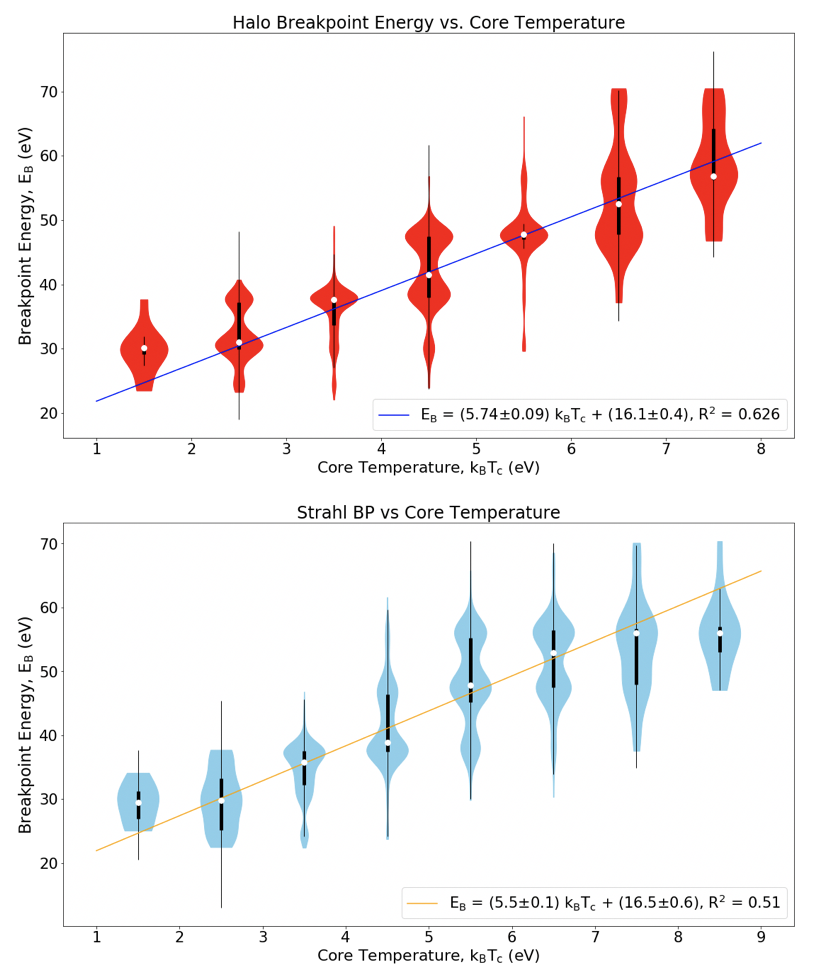MIST
Magnetosphere, Ionosphere and Solar-Terrestrial
Statistics of Solar Wind Electron Breakpoint Energies Using Machine Learning Techniques
By Mayur Bakrania (Mullard Space Science Laboratory, UCL)
Solar wind electron velocity distributions at 1 au consist of a thermal 'core' population and two suprathermal populations: 'halo' and 'strahl'. The core and halo are quasi-isotropic, whereas the strahl typically travels along the parallel and/or anti-parallel direction with respect to the interplanetary magnetic field. The energies at which the halo and strahl populations are separated from the core population are known as the breakpoint energies, and these energies provide useful information on the relative importance of scattering mechanisms.
With Cluster-PEACE data, we analyse energy and pitch angle distributions and use machine learning techniques to separate and classify these solar wind populations. In our statistical study, we apply the K-means algorithm to phase space density distributions over ten years to study the variation of halo and strahl breakpoint energies with solar wind parameters. Key findings include:
- Halo and strahl suprathermal breakpoint energies increase with core temperature, with the halo exhibiting a more positive gradient than the strahl, as shown in the Figure. We conclude low energy strahl electrons are scattering into the core, instead of the halo. This increases the number of Coulomb collisions and extends the perpendicular core population to higher energies, resulting in a larger difference between halo and strahl breakpoint energies at higher core temperatures.
- Suprathermal breakpoint energies decrease with increasing solar wind speed. We also observe distinct profiles for fast and slow solar wind and conclude the origin of the solar wind, i.e., coronal holes for fast wind or streamer belt regions for slow wind, potentially plays a role in the definition of thermal and non-thermal electron populations.
This extensive and novel study reveals key characteristics of the solar wind electron populations. The results provide crucial information on the generation of solar wind electron populations as the solar wind propagates through the heliosphere.

Figure. (Top) `Violin plot' of halo breakpoint energy against core temperature. The blue line shows the line of best fit. The white dots indicate the median of breakpoint energies and the thick black lines show the inter-quartile ranges (IQR). We plot the thin black lines to display which breakpoint energies are outliers. They span from Q3+1.5 X IQR to Q1-1.5 X IQR, where Q3 and Q1 are the upper and lower quartiles, respectively. The horizontal width of the red regions represents the density of data points at that given breakpoint energy. (Bottom) `Violin plot' of strahl breakpoint energy against core temperature. The orange line shows the line of best fit.
Please see the paper for full details:
Bakrania, M. R., Rae, I. J., Walsh, A. P., Verscharen, D., Smith, A. W., Bloch, T. & Watt, C. E. J. (2020). Statistics of solar wind electron breakpoint energies using machine learning techniques, A&A, 639, A46, https://doi.org/10.1051/0004-6361/202037840